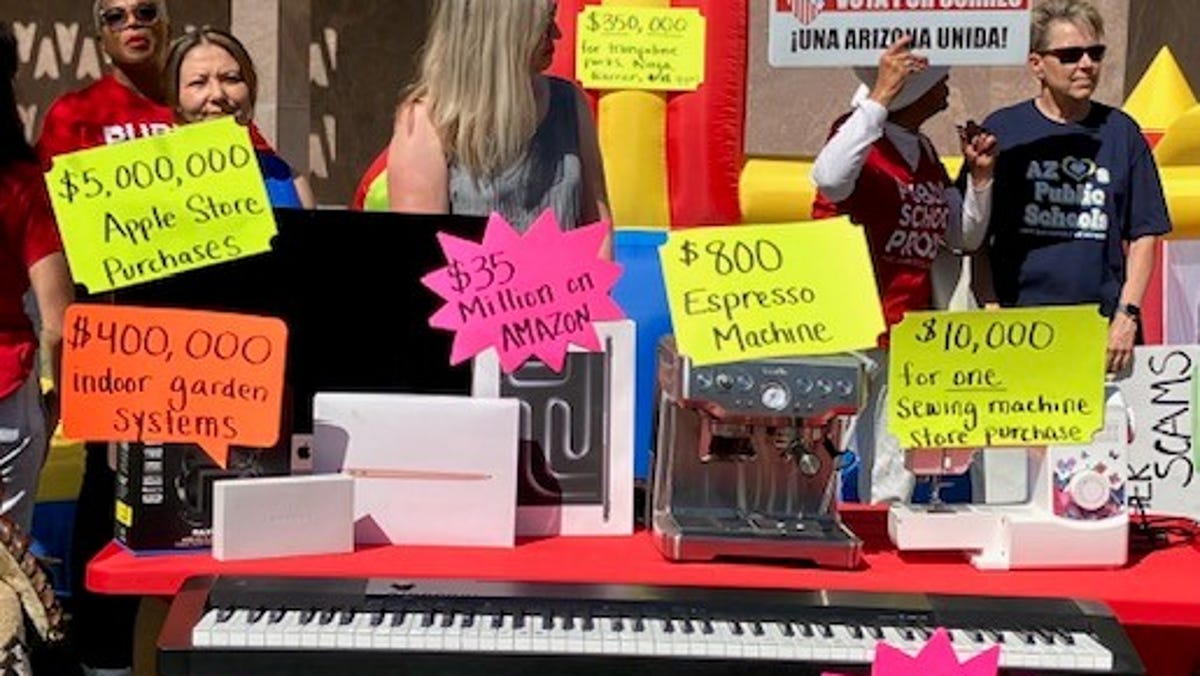Governor Katie Hobbs wants to hold ESA program accountable
Governor Katie Hobbs called for accountability and transparency in Arizona’s ESA program during her State of the State address on January 8, 2024.
Arizona could reduce its budget deficit by reining in its universal school voucher program, critics said at a Capitol news conference on Wednesday, citing examples of what they said was the program’s runaway spending.
From golf clubs to espresso machines to inflatable bounce houses, members and supporters of Save Our Schools hosted what looked like a high-end yard sale on the state Senate lawn. They want to highlight items purchased with taxpayer dollars through the Empowerment Scholarship Account program.
“This is not an appropriate use of our taxpayer funds,” said Save Our Schools Director Beth Lewis. She pored over a list of aggregated expenses, such as $35 million in purchases from Amazon, $2 million for musical instruments and $1.2 million for martial arts instruction, all from public records first compiled and reported by ABC 15.
“A budget without ESA voucher reform is not a budget at all,” Lewis said. Supporters at the press conference echoed this sentiment.
The group argued that the program has cost $800 million this year at a time when the state budget faces a two-year deficit of $1.3 billion. ESA scholarships are paid out of the general K-12 budget and account for 90 percent of public school student funding.
But in almost every case, the program adds costs to the state because of the way the funding formula is written. An analysis last year by the Arizona Association of School Business Officials found that only public charter school students could save money by switching to ESA accounts.
State Schools Superintendent Tom Horne said the ESA program accounts for only a small portion of Arizona’s total student population: just 75,000 students, compared with 1.25 million students in public schools.
“ESA does not pose a threat to public schools,” Horn said in a statement. “But the competition they provide makes public schools perform better, rather than becoming the government monopoly that SOS prefers.”
Horn’s office administers the program.
Rep. Analise Ortiz, D-Phoenix, joined the news conference and said ESA reform is needed now to ease pressure on state coffers.
Ortiz questioned why ESA recipients can spend taxpayer money to buy a piano for their family’s living room, but public schools cannot provide students with personal pianos.
To her right is an upright piano keyboard with a $4,000 price tag. The items on display come from Save Our Schools supporters who brought items from their homes similar to those purchased through the ESA program.
Is school voucher reform coming in Arizona?
Ortiz said the program must now be limited.
“We need this in this year’s budget,” she said of Gov. Katie Hobbs’ proposal to put some guardrails on the program, which has seen its student population increase from two years ago. increased from 12,000 to 75,250.
The chances of this happening are slim to none. The Republican majority in the Legislature strongly supports the ESA program and has resisted calls to scale it back to serve only specific groups of students, such as children with disabilities or youth in foster care.
House Speaker Ben Toma (R-Glendale) is perhaps the plan’s staunchest advocate. He has sponsored legislation in 2022 to expand the ESA program to all school-age students in Arizona.
He said lawmakers were open to some “process improvements” but rejected any idea of narrowing the scope of the program.
“Governor Hobbs has been very clear on where he stands on things,” he said of Arizona’s Democratic governor. “I have it too.”
Hobbs proposed some policy changes at the beginning of the year that she said would bring some transparency and accountability to the program. These include mandatory fingerprint background checks for teachers who supervise ESA students and requiring private schools to report graduation and chronic absence rates.
Thoma said the changes to ESA’s plans were part of ongoing closed-door budget negotiations but were not a major issue.
Lawmakers and Hobbs need to agree on a budget by the end of June in order to have a spending plan in place when the new budget year begins on July 1.
“The most important thing is to make the numbers count,” Thoma said. The math has to be real.
That number would be necessary to eliminate a $650 million deficit this fiscal year and a $676 million deficit next year, according to an April legislative budget staff report.
While consideration has been given to not impacting the Department of Public Safety and Child Safety and K-12 budgets, cuts to state agencies are inevitable.
Contact reporters: maryjo.pitzl@arizonarepublic.com Or call 602-228-7566 and follow her on Threads and X (formerly Twitter) @maryjpitzl.




